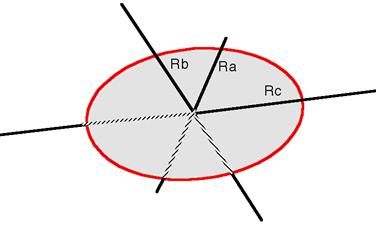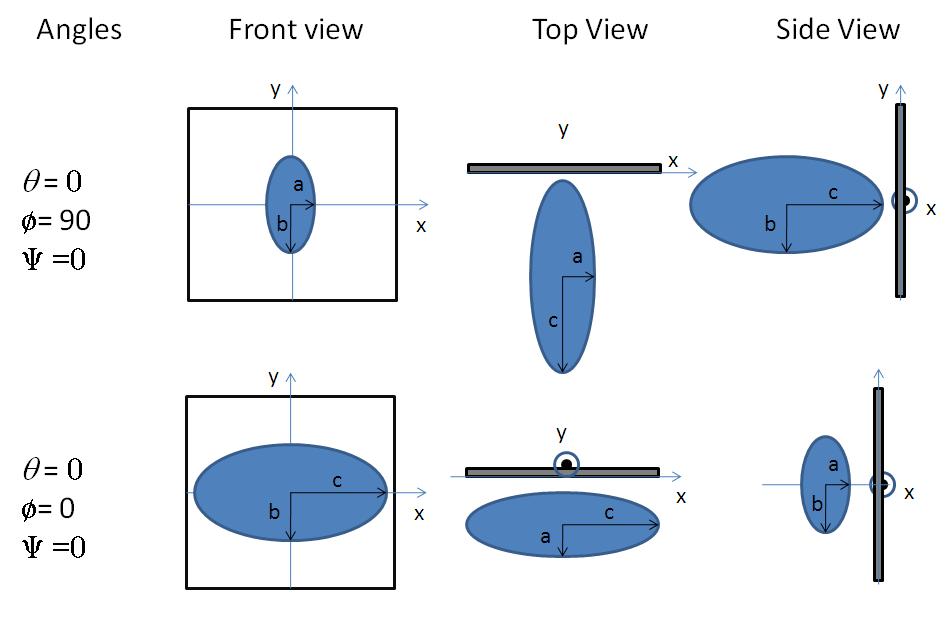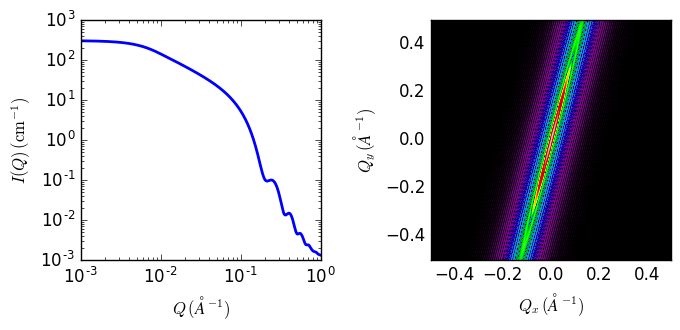triaxial_ellipsoid
Ellipsoid of uniform scattering length density with three independent axes.
| Parameter | Description | Units | Default value |
|---|---|---|---|
| scale | Source intensity | None | 1 |
| background | Source background | cm-1 | 0.001 |
| sld | Ellipsoid scattering length density | 10-6Å-2 | 4 |
| sld_solvent | Solvent scattering length density | 10-6Å-2 | 1 |
| radius_equat_minor | Minor equatorial radius | Å | 20 |
| radius_equat_major | Major equatorial radius | Å | 400 |
| radius_polar | Polar radius | Å | 10 |
| theta | In plane angle | degree | 60 |
| phi | Out of plane angle | degree | 60 |
| psi | Out of plane angle | degree | 60 |
The returned value is scaled to units of cm-1 sr-1, absolute scale.
All three axes are of different lengths with \(R_a \leq R_b \leq R_c\) Users should maintain this inequality for all calculations.
where the volume \(V = 4/3 \pi R_a R_b R_c\), and the averaging \(\left<\ldots\right>\) is applied over all orientations for 1D.

Fig. 37 Ellipsoid schematic.
Definition
The form factor calculated is
where
To provide easy access to the orientation of the triaxial ellipsoid, we define the axis of the cylinder using the angles \(\theta\), \(\phi\) and \(\psi\). These angles are defined on Fig. 38 . The angle \(\psi\) is the rotational angle around its own \(c\) axis against the \(q\) plane. For example, \(\psi = 0\) when the \(a\) axis is parallel to the \(x\) axis of the detector.

Fig. 38 The angles for oriented ellipsoid.
The radius-of-gyration for this system is \(R_g^2 = (R_a R_b R_c)^2/5\).
The contrast is defined as SLD(ellipsoid) - SLD(solvent). In the parameters, \(R_a\) is the minor equatorial radius, \(R_b\) is the major equatorial radius, and \(R_c\) is the polar radius of the ellipsoid.
NB: The 2nd virial coefficient of the triaxial solid ellipsoid is calculated based on the polar radius \(R_p = R_c\) and equatorial radius \(R_e = \sqrt{R_a R_b}\), and used as the effective radius for \(S(q)\) when \(P(q) \cdot S(q)\) is applied.
Validation
Validation of our code was done by comparing the output of the 1D calculation to the angular average of the output of 2D calculation over all possible angles.

Fig. 39 1D and 2D plots corresponding to the default parameters of the model.
References
L A Feigin and D I Svergun, Structure Analysis by Small-Angle X-Ray and Neutron Scattering, Plenum, New York, 1987.